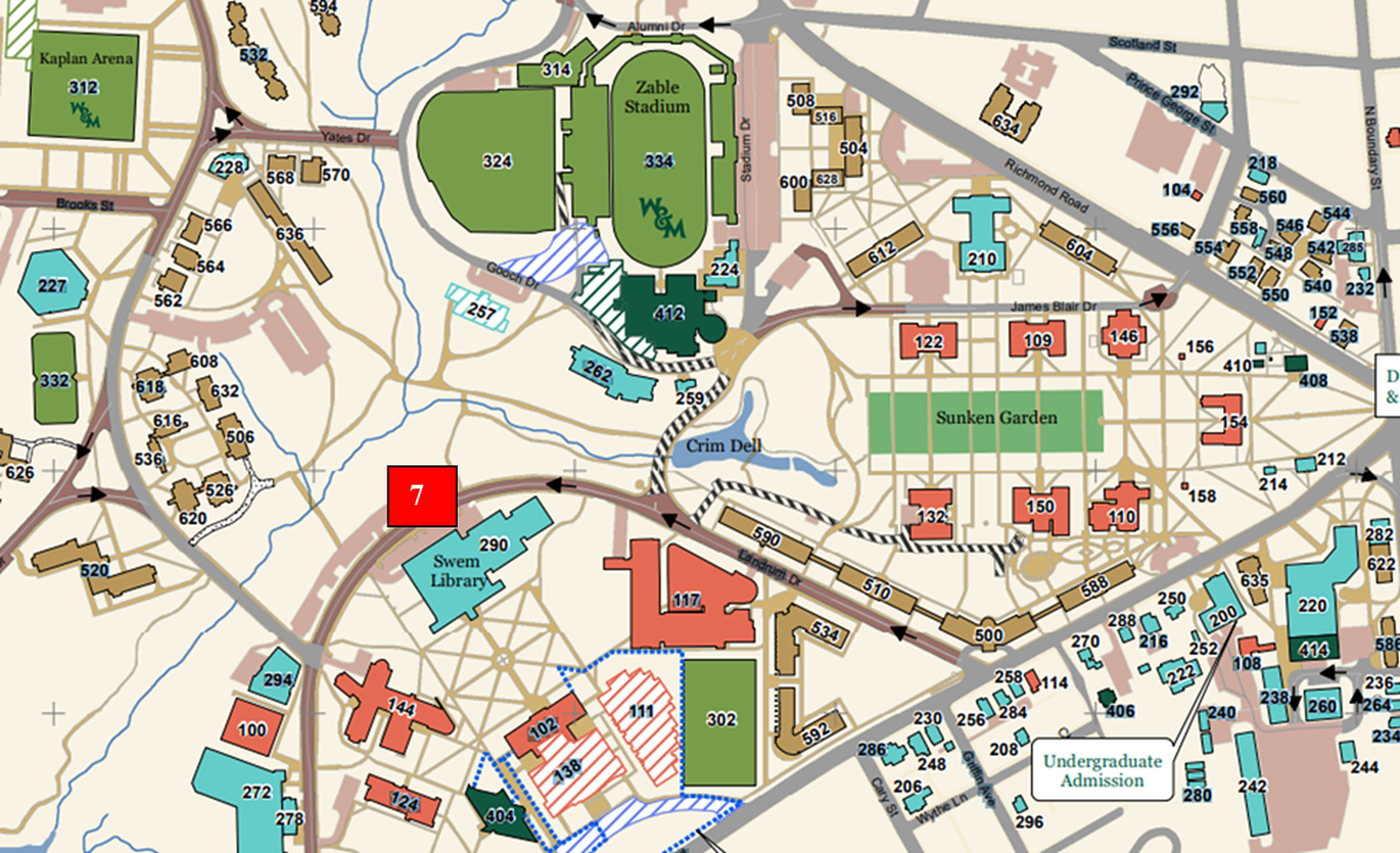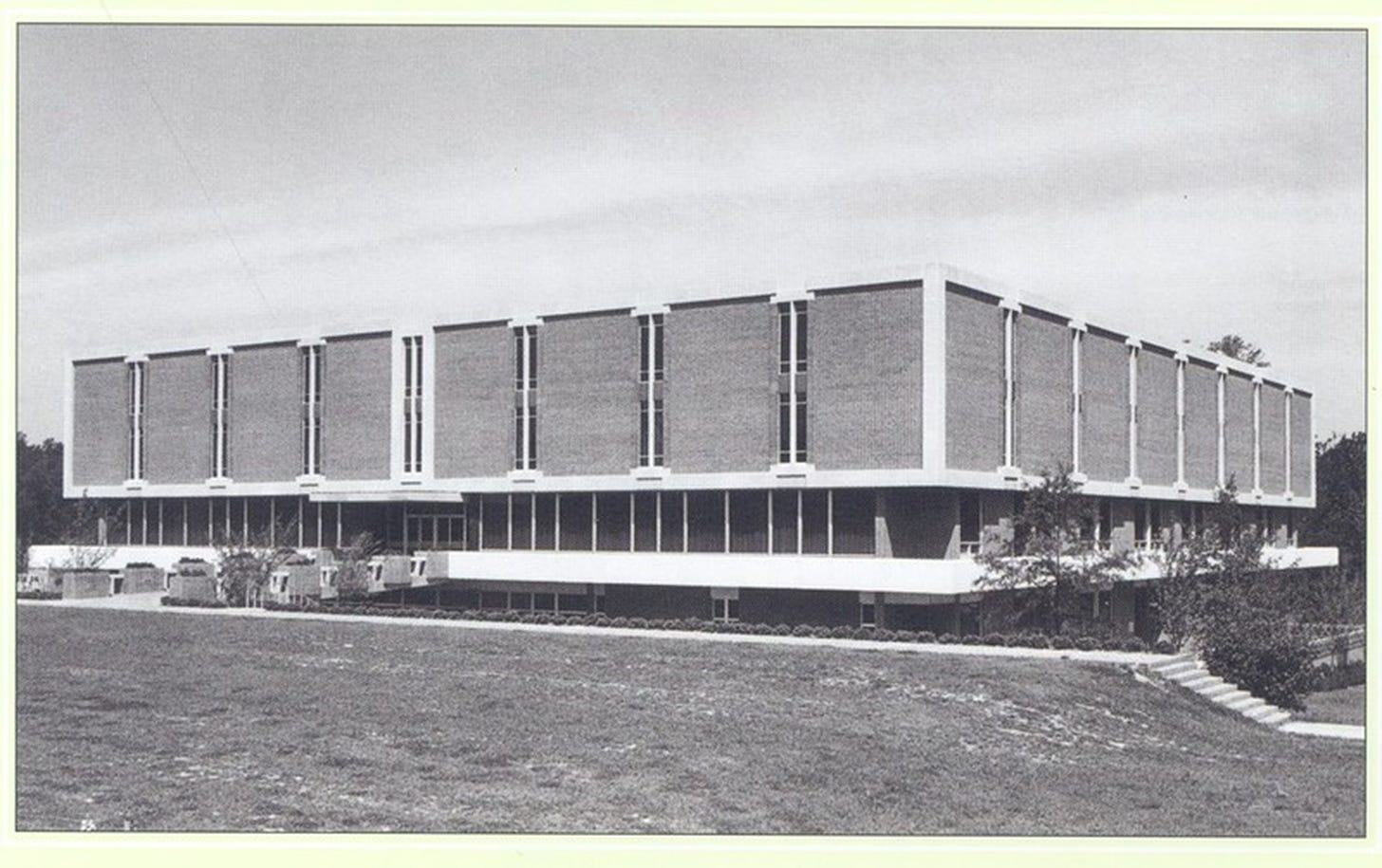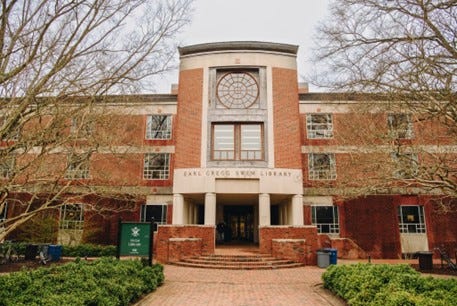

On June 17, I wrote about Tucker Hall, which served as the college library between 1909 and 1966. Today I’m writing about the “new” library, on Landrum Drive on the expanded college campus.
Here’s how one website describes the history of this facility: (https://tribetrek.wm.edu/items/show/26)
The Earl Gregg Swem Library is located on Landrum Drive between Millington Hall and Small Hall. William & Mary has been consistently ranked in the top 10 in the Princeton Review rankings of best university libraries in recent years. The library is named for Earl Gregg Swem (1870-1965), William & Mary’s librarian from 1920-1944. The first library building on campus was dedicated in 1909 and opened simply as the Library. That building is today known as Tucker Hall.
By the early 1950s, concern mounted about the threatening inadequacies of the library that is now Tucker Hall (the university’s first library was housed in the Wren Building). With the expansion of campus under President Davis Y. Paschall, land was finally available for the new library. Construction began in 1964, and the dedication ceremony took place during Charter Day exercises in 1966.
By the 1980s, the need for additional shelving resulted in an addition made to all four floors of the front of the building. A decade later, there were critical space needs for Special Collections, computers, and group study rooms. In 1998, ground was broken for two three-story pavilions which were added to the east side of the library. The larger pavilion features a spacious reading room on the first floor and compact shelving throughout; the smaller houses rare books, university archives, and the papers and memorabilia of Chief Justice Warren E. Burger. As it presently stands, the Earl Gregg Swem Library was rededicated on Charter Day, 2005.
The original statue of Lord Botetourt that stood in the Wren Yard until 1958 is currently located in the Botetourt Gallery on the ground floor. A number of portraits and sculptures by Carl Roseberg are also on display throughout the library. Notable resources within Swem Library include the Media Center and the Special Collections Research Center.

I remember thinking this library was simply a miracle when it opened in 1966, during my second semester at William and Mary. The old library had been cramped and dark, and it operated on a closed-stacks system that prohibited students from roaming the stacks and finding the materials they needed. The new library was open and bright and seemed like heaven to a library nerd like me.
Tim and I regularly studied in the library – not because we necessarily needed to use library materials, but just because it was a comfortable and quiet place to get work done. I remember one Friday afternoon when we had been studying at the library and decided to go to dinner before coming back to continue working. We left our books and so forth on the carrels we had been working at (we didn’t worry about leaving our stuff there). When we came back, we were shocked to find that the library had closed while we were gone – it closed at 5:00 pm and we weren’t aware of that. So we HAD to go to a party that night, but we went back as soon as the building opened the next day, found all of our stuff just as we had left it, and continued studying for a couple more hours.
I had only one class in the library – a history class that met in a basement classroom. I didn’t take much history in college – this may have been my only class – and I didn’t do very well in it.
Since moving back to Williamsburg 24 years ago, I have used the library a lot. I have spent a fair amount of time in the library as I research for the Osher classes I teach. As local residents, we have borrowing privileges at the library, and I take full advantage of that benefit. In addition, I have taken several Osher classes that meet at the library:
Vast Early America is the umbrella term used by the Omohundro Institute of Early American History & Culture to describe its research focus. It was also an Osher class co-taught by several history professors at the Institute, which is an independent research organization connected to the history department at the college. This organization supports scholars and scholarship focused on the field of early American History. In a 2019 article published in the Omohundro Institute blog in 2019, then-director Karin Wolf wrote in detail about the scope of the Institute’s work in broadening the historical focus of early America to include all of the forces impacting the Americas. To read her article, click on this link. https://blog.oieahc.wm.edu/vast-early-america-three-simple-words/. In the article she makes an interesting observation, calling on the interest in the musical Hamilton. In this musical, Lin-Manuel Miranda asks the unforgettable question:
How does a bastard, orphan, son of a whore
And a Scotsman, dropped in the middle of a forgotten spot
In the Caribbean by providence impoverished
In squalor, grow up to be a hero and a scholar?
According to Dr. Wolf, this is the question that underpins the Vast Early America project and the substance of the Osher course the program offered.
And oh yeah, by the way, the Omohundro Institute is currently the home of the podcast Ben Franklin’s World, which has produced 331 hour-long episodes since the podcast began in 2014.
Capstone seminars (History 491) are required of history majors at the college. Professor Michael Butler came up with the brilliant idea a few years ago to give Osher members an opportunity to be part of his capstone seminars on American Diplomatic History. His 30 years of experience in the diplomatic corps enliven his academic expertise to provide a wonderful final academic experience for graduating seniors.
Osher members become the audience for his students as they refine their final research projects. I have been part of this class (which meets in a high-tech classroom on the ground floor of the library) for three semesters. It is just a hoot. I love to watch as these fledgling historians make their first attempts to leave the nest, going out on their own to develop their research topics, find and then figure out how to use the evidence to support their research hypotheses, and then present their findings to an audience of old folks who have lots of education and experience in the areas of their research. I come away from each session marveling at the intelligence and confidence of these young folks. The kids are all right, I tell you.
Libraries are great places in general, and Swem is currently ranked as the best college library in Virginia and among the top 20 college libraries in the country.
Join me next week as my campus tour takes us to Stop 8, Small Hall. (The name does not refer to the size of the building or any of the rooms in it.)











I've always loved libraries. It started one summer when I walked into my hometown library. It was dark and cool. It smelled wonderful. I sat in a windowsill bench and read. Sigh.
So entertaining, Karen! I can picture you and Tim HAVING to go to the party! Happy 4th of July!